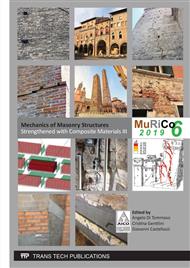[1]
Foti, D. (2016). Innovative techniques for concrete reinforcement with polymers. Construction and Building Materials, 112, 202-209.
DOI: 10.1016/j.conbuildmat.2016.02.111
Google Scholar
[2]
Cascardi, A., Micelli, F., & Aiello, M. A. (2018). FRCM-confined masonry columns: experimental investigation on the effect of the inorganic matrix properties. Construction and Building Materials, 186, 811-825.
DOI: 10.1016/j.conbuildmat.2018.08.020
Google Scholar
[3]
Maddaloni, G., Cascardi, A., Balsamo, A., Di Ludovico, M., Micelli, F., Aiello, M. A., & Prota, A. (2017). Confinement of full-scale masonry columns with FRCM systems. In Key Engineering Materials (Vol. 747, pp.374-381). Trans Tech Publications.
DOI: 10.4028/www.scientific.net/kem.747.374
Google Scholar
[4]
Minafò, G., & La Mendola, L. (2018). Experimental investigation on the effect of mortar grade on the compressive behaviour of FRCM confined masonry columns. Composites Part B: Engineering, 146, 1-12.
DOI: 10.1016/j.compositesb.2018.03.033
Google Scholar
[5]
Ombres, L., & Verre, S. (2018). Masonry columns strengthened with Steel Fabric Reinforced Cementitious Matrix (S-FRCM) jackets: experimental and numerical analysis. Measurement.
DOI: 10.1016/j.measurement.2018.05.114
Google Scholar
[6]
Ivorra, S., Bru Orts, D., Galvañ Morena, A., Silvestri, S., Apera, C., & Foti, D. (2017). TRM Reinforcement of masonry specimens for seismic areas. International Journal of Safety and Security Engineering, Vol 7 (4), p.463 – 474.
DOI: 10.2495/safe-v7-n4-463-474
Google Scholar
[7]
Bieker, C., Seim, W., & Stürz, J. (2002). Post-Strengthening of Masonry Columns by use of Fiber–reinforced polymers (FRP). In Third International Conference of Composites in Infrastructure, San Francisco.
Google Scholar
[8]
Masia, M. J., & Shrive, N. G. (2003). Carbon fibre reinforced polymer wrapping for the rehabilitation of masonry columns. Canadian journal of civil engineering, 30(4), 734-744.
DOI: 10.1139/l03-015
Google Scholar
[9]
Krevaikas, T. D., & Triantafillou, T. C. (2005). Masonry confinement with fiber-reinforced polymers. Journal of Composites for Construction, 9(2), 128-135.
DOI: 10.1061/(asce)1090-0268(2005)9:2(128)
Google Scholar
[10]
Aiello, M. A., Micelli, F., & Valente, L. (2007). Structural upgrading of masonry columns by using composite reinforcements. Journal of Composites for Construction, 11(6), 650-658.
DOI: 10.1061/(asce)1090-0268(2007)11:6(650)
Google Scholar
[11]
Aiello, M. A., Micelli, F., & Valente, L. (2009). FRP confinement of square masonry columns. Journal of composites for construction, 13(2), 148-158.
DOI: 10.1061/(asce)1090-0268(2009)13:2(148)
Google Scholar
[12]
Alecci, V., Bati, S. B., & Ranocchiai, G. (2009). Study of brick masonry columns confined with CFRP composite. Journal of Composites for Construction, 13(3), 179-187.
DOI: 10.1061/(asce)1090-0268(2009)13:3(179)
Google Scholar
[13]
Di Ludovico, M., D'Ambra, C., Prota, A., & Manfredi, G. (2010). FRP confinement of tuff and clay brick columns: Experimental study and assessment of analytical models. Journal of Composites for Construction, 14(5), 583-596.
DOI: 10.1061/(asce)cc.1943-5614.0000113
Google Scholar
[14]
Faella, C., Martinelli, E., Paciello, S., Camorani, G., Aiello, M. A., Micelli, F., & Nigro, E. (2011). Masonry columns confined by composite materials: Experimental investigation. Composites Part B: Engineering, 42(4), 692-704.
DOI: 10.1016/j.compositesb.2011.02.001
Google Scholar
[15]
Micelli, F., Di Ludovico, M., Balsamo, A., & Manfredi, G. (2014). Mechanical behaviour of FRP-confined masonry by testing of full-scale columns. Materials and structures, 47(12), 2081-2100.
DOI: 10.1617/s11527-014-0357-9
Google Scholar
[16]
Witzany, J., Čejka, T., & Zigler, R. (2014). Failure mechanism of compressed short brick masonry columns confined with FRP strips. Construction and Building materials, 63, 180-188.
DOI: 10.1016/j.conbuildmat.2014.04.041
Google Scholar
[17]
Valdés, M., Concu, G., & De Nicolo, B. (2014). FRP Strengthening of Masonry Columns: Experimental Tests and Theoretical Analysis. Key Engineering Materials, 624.
DOI: 10.4028/www.scientific.net/kem.624.603
Google Scholar
[18]
A. Balsamo; G. Maddaloni; F. Micelli; A. Prota; G. Melcangi (2018). Experimental behaviour of full scale masonry columns confined with FRP or FRCM systems,, REHABEND 2018 Euro-American Congress on Construction Pathology, Rehabilitation Technology and Heritage Management, Caceres, Spagna, Maggio (2018).
DOI: 10.4028/www.scientific.net/kem.747.374
Google Scholar
[19]
Cascardi, A., Micelli, F., & Aiello, M. A. (2017). An Artificial Neural Networks model for the prediction of the compressive strength of FRP-confined concrete circular columns. Engineering Structures, 140, 199-208.
DOI: 10.1016/j.engstruct.2017.02.047
Google Scholar
[20]
Cascardi, A., Micelli, F., & Aiello, M. A. (2016). Unified model for hollow columns externally confined by FRP. Engineering Structures, 111, 119-130.
DOI: 10.1016/j.engstruct.2015.12.032
Google Scholar
[21]
Minafò, G., D'Anna, J., Cucchiara, C., Monaco, A., & La Mendola, L. (2017). Analytical stress-strain law of FRP confined masonry in compression: Literature review and design provisions. Composites Part B: Engineering, 115, 160-169.
DOI: 10.1016/j.compositesb.2016.10.019
Google Scholar
[22]
UNI, 2000. UNI EN 1926: Metodi di prova per pietre naturali – Determinazione della resistenza a compressione, Ente Nazionale Italiano di Unificazione, Milano.
Google Scholar
[23]
UNI, 2001. UNI EN 1015-11: Metodi di prova per malte per opere murarie – Determinazione della resistenza a flessione e a compressione della malta indurita, Ente Nazionale Italiano di Unificazione, Milano.
Google Scholar
[24]
ASTM D3039 / D3039M-17, Standard Test Method for Tensile Properties of Polymer Matrix Composite Materials, ASTM International, West Conshohocken, PA, (2017).
Google Scholar
[25]
CNR-DT 200 R1 (2012) Guide for the design and construction of externally bonded FRP systems for strengthening existing structures. Italian Council of Research (CNR), Rome.
Google Scholar
[26]
Zeng, J. J., Guo, Y. C., Gao, W. Y., Chen, W. P., & Li, L. J. (2018). Stress-strain behavior of concrete in circular concrete columns partially wrapped with FRP strips. Composite Structures, 200, 810-828.
DOI: 10.1016/j.compstruct.2018.05.001
Google Scholar


